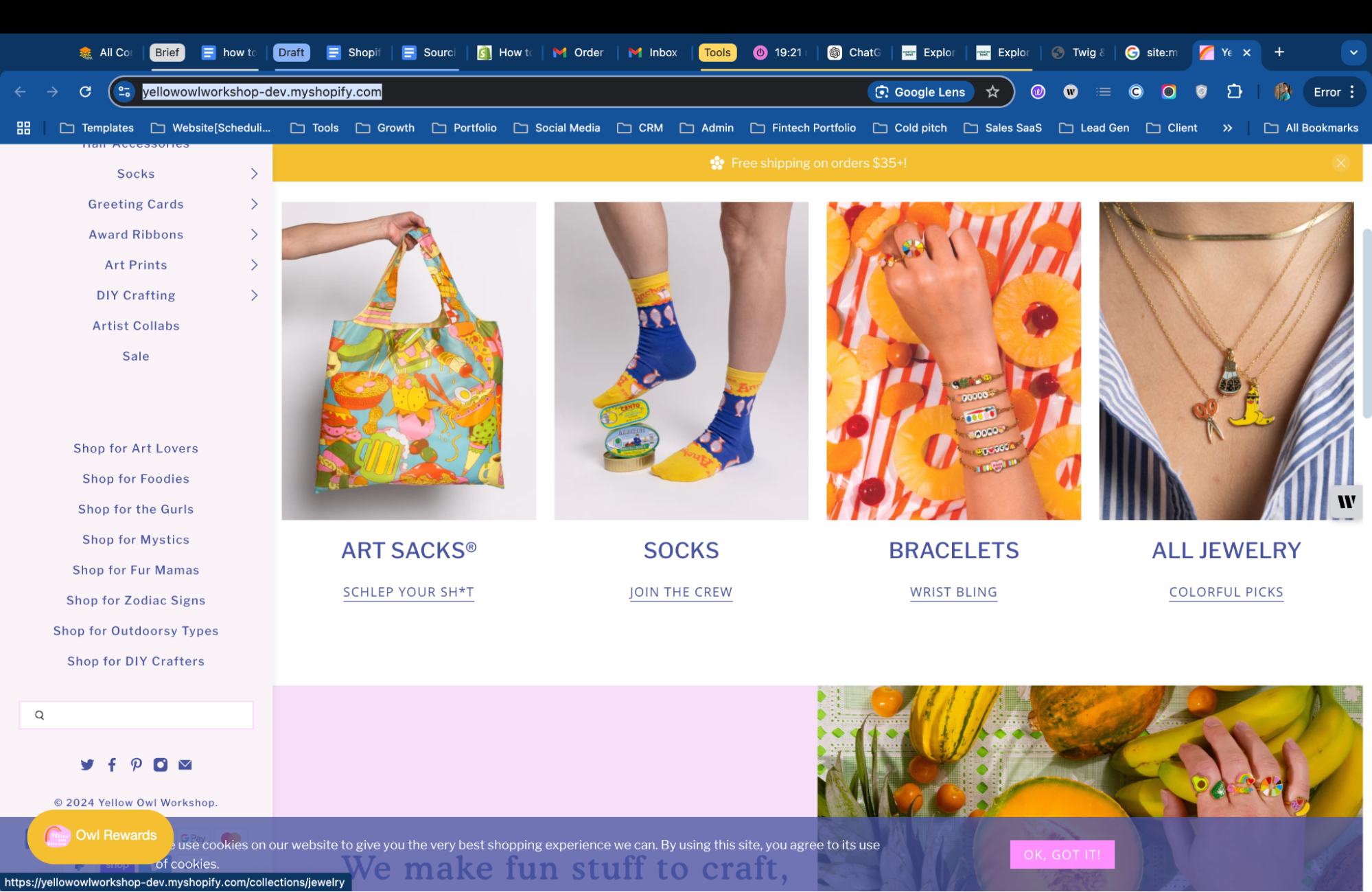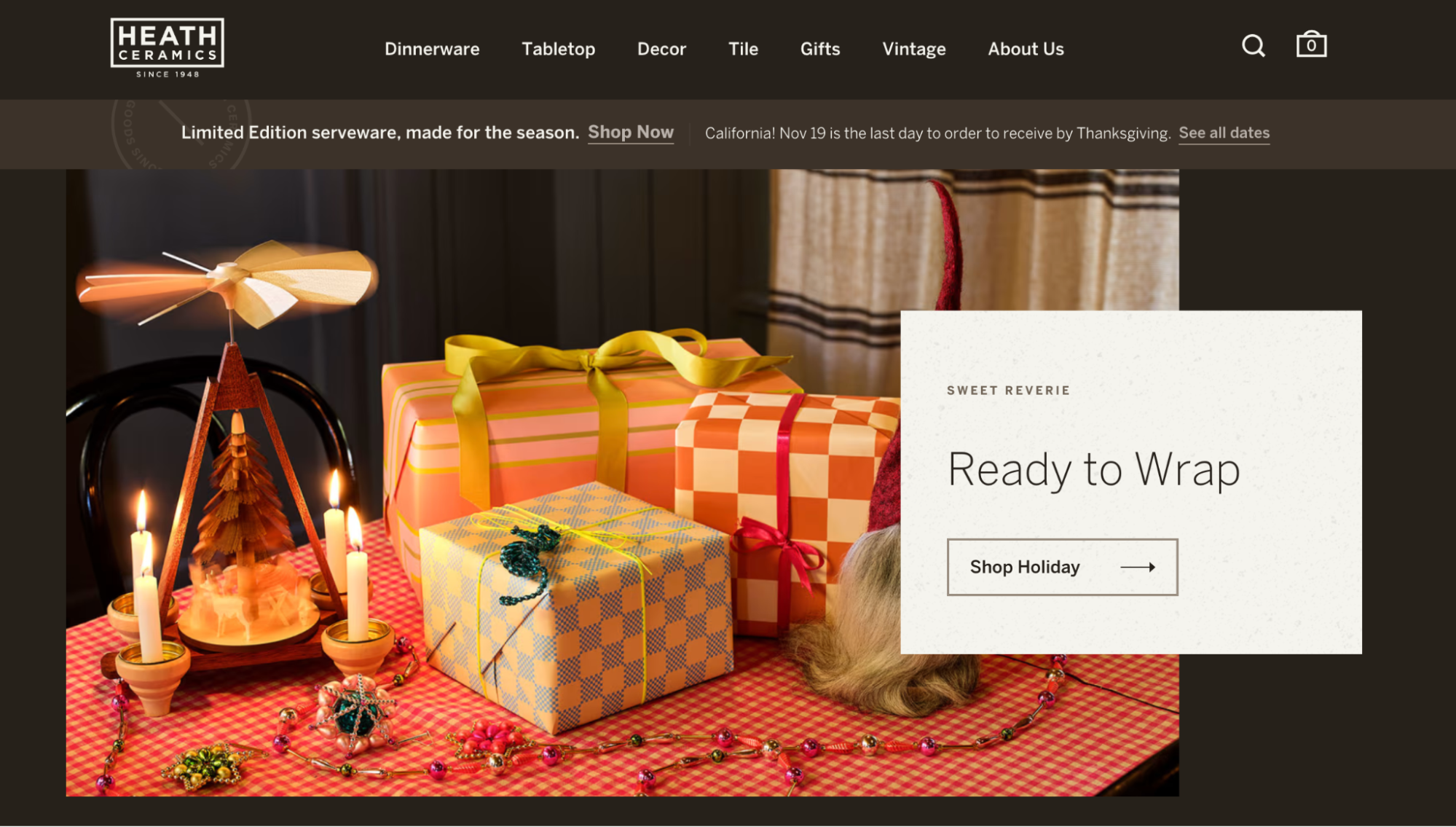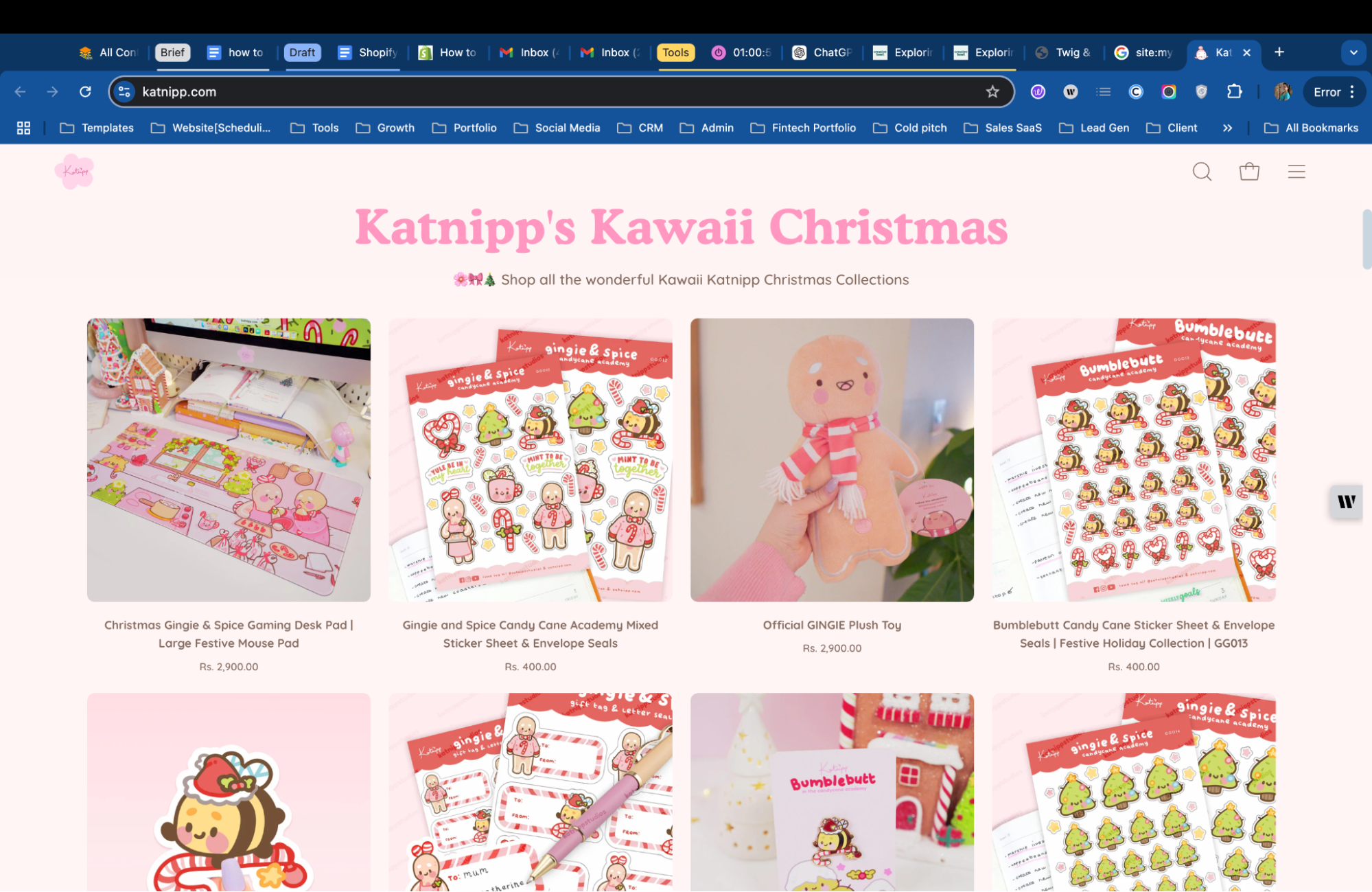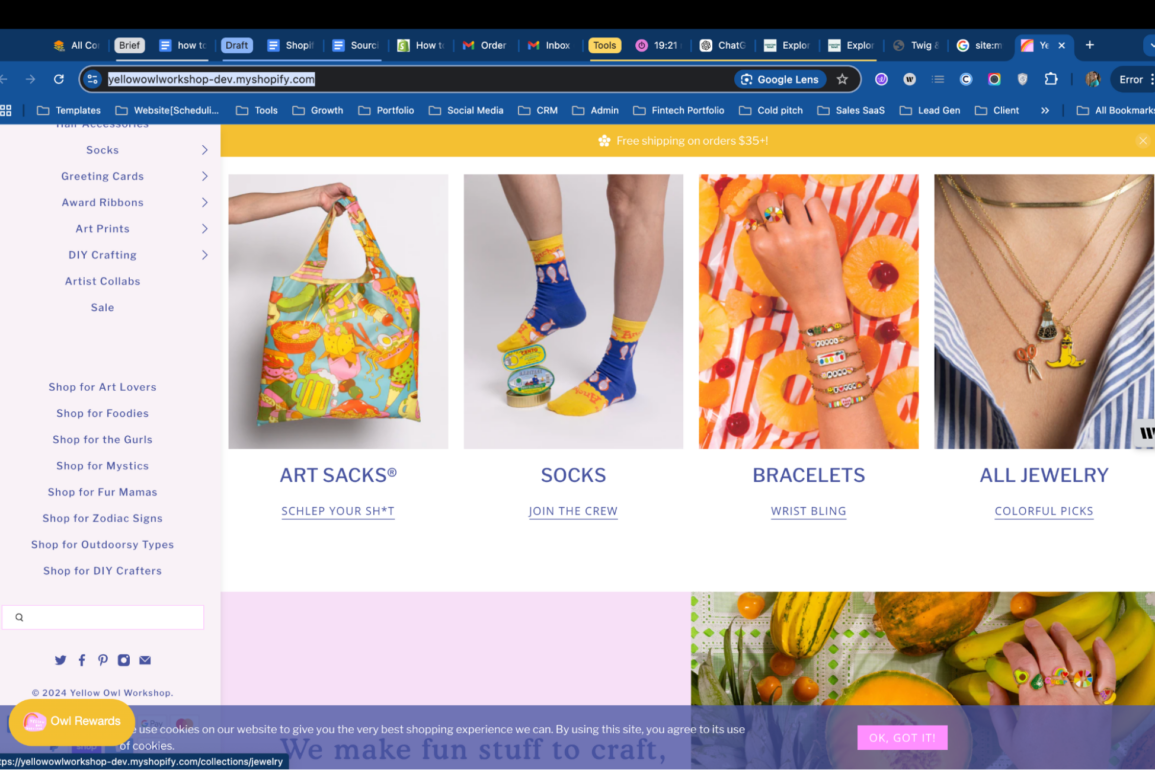If you have a talent for transforming raw materials—wood, wool, wax, or anything else—into something beautiful, you’re in a great position to start a business.
Crafting not only reduces stress and builds confidence, it also offers significant business opportunities. The global handicrafts market reached $830.4 billion in 2023 and is projected to grow at 9.2% annually, reaching $1.8 trillion by 2032.
Starting your own craft business lets you join this growing industry while earning money doing what you love. Here’s your complete guide to launching a successful craft business.
How to start a craft business
Starting a business requires learning new skills, expanding your knowledge, and building your professional network. As a skilled craftsperson, you already have the vision, dedication, and attention to detail that will help you succeed as an entrepreneur. Follow these 11 steps to develop your craft business plan and start selling your products.
- Research your market and audience
- Define your unique selling proposition
- Design your products
- Choose where to sell your products
- Build your brand identity
- Create a marketing plan
- Plan your business finances
- Form your business
- Purchase supplies and start production
- Plan for shipping and fulfillment
- Set up your online store
1. Research your market and audience
Market research goes beyond studying competitor websites. For craft sellers, it means discovering niche communities, understanding what motivates potential customers, and finding where your products can make a real difference. Explore forums, browse Etsy and Amazon Handmade, and join social media groups where craft products get attention.
For example, if you create ceramic planters, you might initially target homeowners aged 30 to 45 who love indoor gardening and modern décor. But deeper research could uncover a valuable niche: urban millennials passionate about eco-friendly products. This insight could inspire unique offerings—like biodegradable packaging or limited-edition glazes inspired by sustainable materials.
To make the most of your market research:
- Create detailed customer personas that capture demographics and interests. Example: “Jane, 35, lives in the city, values sustainable home décor, and collects handcrafted items.”
- Understand key purchase motivators. What drives customers to buy—function, decoration, or gifts? Use these insights to help shape your product messaging.
- Talk to potential buyers through your community, friends, or online forums to learn what they want in craft items. Even casual conversations can reveal priorities about quality, materials, or local production.
- Map seasonal trends and opportunities to time your product launches and promotions effectively.
- Look beyond online platforms to local boutiques, pop-up markets, or subscription boxes that feature handmade items. Local partnerships often build strong customer loyalty.
- Follow influencers in your niche to spot emerging trends and potential collaboration opportunities.
2. Define your unique selling proposition
Your unique selling proposition (USP) makes your products stand out in a crowded market. It’s why customers should choose your craft over similar items. A strong USP connects with your audience’s needs and highlights what makes your work special. Here’s how to develop yours:
- Identify your core strengths: What do you do exceptionally well? This could be a specific technique, outstanding quality, or your choice of sustainable materials.
- Study gaps in competitor offerings: Look for what’s missing in similar products. If your area lacks eco-friendly décor, your sustainable, handcrafted home goods could fill that need.
- Connect with customer values: Focus on what matters to your audience, such as sustainability, durability, or unique design. Choose one or two key values to emphasize.
- Create a memorable statement: Keep it clear and compelling. Instead of “unique ceramics,” try “nature-inspired, eco-friendly ceramics that bring the outdoors in.”
- Test and improve: Share your USP with potential customers to see if it resonates. Use their feedback to refine it into an authentic and clear message.
3. Design your products
Design your product line around your target audience’s needs to increase your chances of success.
Follow these steps when designing your products:
- Define product purpose: Outline what each product offers. Consider if it’s functional, decorative, or both, and make sure it aligns with your target audience’s values.
- Research popular aesthetics: Study trending styles in your niche, like boho designs for home décor, minimalist jewelry, or playful items for kids.
- Choose materials thoughtfully: Pick materials that match your brand and appeal to customers. For eco-conscious buyers, consider sustainable or upcycled materials.
- Develop prototypes: Create samples to test your design ideas. This helps you perfect sizing, colors, and quality before starting full production.
- Get early feedback: Show your prototypes to friends, community members, or potential customers. Their input on style, functionality, and durability helps ensure your products connect with buyers.
- Plan product variations: Consider offering different colors, sizes, or patterns to appeal to varied preferences.
- Price strategically: Calculate production costs to set profitable prices that work with your audience’s budget.
Check if your products need to meet specific regulations before you can sell them. For example, food items must meet safety standards, while soaps and cosmetics have their own guidelines for manufacturing and sales.
📚 Learn: 12 Easy and Profitable Crafts to Make and Sell in 2024
4. Choose where to sell your products
You have several options for selling your crafts. Many craft business owners start at local markets or partner with local merchants. Others join online marketplaces like Amazon Handmade or Etsy alternatives.
You can also launch your own online store. Starting is simpler than you might think—set up a Shopify store using a free theme and customize it with your photos, fonts, and colors. Pick a website theme that suits your brand and shows off your products effectively. With Shopify, you can also sell directly through social media like Instagram, Facebook, and TikTok.
Consider these factors when choosing your selling platforms:
- Platform costs: Compare listing fees, transaction fees, and subscription costs across platforms. For example, Etsy charges per-listing fees, while Shopify offers monthly subscriptions.
- Setup requirements: Some platforms like Etsy are ready to use quickly, while custom Shopify stores offer more flexibility but need more setup time. Choose based on your technical comfort level.
- Brand control: If you want full control over your brand’s look and feel, your own Shopify store gives you more freedom than marketplaces like Amazon Handmade or Etsy.
- Shipping options: Look at each platform’s shipping tools. Some offer integrated solutions, while others let you manage shipping yourself—important to consider as you grow.
5. Build your brand identity
Your brand identity combines your company’s message and visual style. Create a complete brand identity that includes:
- Logo and business name: Design a logo and choose a name that captures your brand’s style and purpose.
- Color palette: Select colors that evoke the right emotions and use them consistently across your materials.
- Typography: Choose fonts that match your brand’s personality and remain readable on all platforms.
- Imagery style: Decide on your visual approach, from product photography to lifestyle images that represent your brand.
- Voice and tone: Develop a consistent communication style that fits your brand—whether friendly, professional, or playful.
- Tagline: Create a memorable phrase that captures what makes your business special.
6. Create a marketing plan
A marketing plan helps you reach potential customers. While you’ll refine your strategy over time, creating an initial plan helps you estimate your marketing budget and prepare for launch.
Include these key elements in your plan:
- Marketing goals
- Key messages
- Marketing channels (social media, email, online advertising, influencer partnerships)
- Social media account setup
Consider these marketing approaches for your craft business:
7. Plan your business finances
Good financial planning helps you run a profitable business. You’ll need to estimate your expenses, price your products, and calculate profit margins. If you plan to seek investors or apply for a small business loan, create a formal business plan.
Start by calculating these expenses:
- Startup costs: Licensing fees, equipment, and initial marketing and branding costs.
- Direct costs: Craft supplies, packaging, shipping, and any other production and fulfillment costs.
- Overhead costs: Software subscriptions, marketplace fees, marketing costs, insurance, and other recurring expenses associated with running your businesses (but not producing products).
Calculate your product costs by adding up expenses for materials, any overhead, and your startup costs for getting the business up and running. Then determine your selling price by adding a markup. Your markup is your profit, typically 20% to 100% of production costs. Use a profit margin calculator to determine the right markup for your products.
Compare your prices to similar products. You may need to adjust based on market response, but avoid simply cutting your markup to compete. Instead, look for ways to reduce overhead or production costs. If you can’t lower costs, you might be comparing yourself to the wrong businesses—look for competitors selling premium products at similar price points.
8. Form your business
Choose a business structure, like a sole proprietorship or LLC. Consult your state’s Department of Revenue and Taxation website to learn if you need a business license or registration.
Requirements often depend on your business entity type. Many states don’t require sole proprietorships to get business licenses, but you’ll need to register your business name with a doing business as (DBA) to open a business bank account, accept payments, and separate personal and business finances.
If you plan to sell across state lines, research registration and sales tax requirements for those regions.
9. Purchase supplies and start production
After forming your business, you’re ready to start making products. Find wholesale suppliers, choose vendors, and order your launch supplies.
Your initial production volume depends on your business model and expected sales. For custom or made-to-order items, you might only need samples for product photos. For craft fairs, brick-and-mortar sales, or high anticipated order volumes, consider building inventory before launch.
10. Plan for shipping and fulfillment
A strong shipping and fulfillment strategy helps you deliver products on time, in perfect condition, and at reasonable costs. Create your plan by addressing these key areas:
- Select shipping methods: Choose between standard, express, or free shipping options based on your budget and customer expectations.
- Calculate shipping costs: Use product weights and dimensions to estimate accurate shipping costs. Decide whether to pass costs to customers, absorb them, or offer free shipping with minimum purchase.
- Choose packaging materials: Select durable packaging that protects your product and reflects your brand—like biodegradable options for eco-friendly brands.
- Arrange fulfillment: Decide if you’ll handle packing and shipping yourself, partner with a fulfillment service, or use integrated solutions like Shopify’s Fulfillment Network.
- Create your returns policy: Sharing a clear, customer-friendly returns policy builds trust.
- Anticipate seasonal demand: Plan for holidays by preparing extra inventory or hiring additional staff.
11. Set up your online store
If you’re selling crafts online, your final step before launch is creating your store. Use an ecommerce platform like Shopify to build your website, showcase products, and accept various payment methods. Here’s how to get started with Shopify:
- Create your account: VisitShopify.com and sign up. Start with a free trial to explore the platform.
- Choose your theme: Browse Shopify’s free and premium themes. Pick a mobile-friendly design that showcases your products effectively and matches your brand’s style.
- Customize your design: Add your logo, set your brand colors, choose fonts, and create a clean layout using high-quality images.
- Add your products: Navigate to the Products section to add detailed descriptions, clear photos, pricing, and product variants. Include relevant keywords to improve search visibility.
- Set up payment and shipping: Enable credit card payments, PayPal, and other payment methods. Configure shipping rates and tax calculations.
- Create essential pages: Add About Us, Contact, FAQ, and policy pages to build trust and help customers find important information.
- Test and launch: Review all pages and functions, test payment processing, check mobile responsiveness, then remove password protection when ready. Start promoting through your marketing channels.
Successful craft business examples
When it comes to successful craft businesses, what sets them apart is a memorable brand, focused product line, and dedication to quality. Here are three brands that show what’s possible with creativity, hard work, and smart strategy:
Yellow Owl Workshop

Yellow Owl Workshop stands out with quirky, colorful designs across its jewelry and art supplies. Its whimsical brand identity has helped it build a unique position in the craft market, attracting customers who love playful, distinctive items.
Heath Ceramics

Heath Ceramics creates handcrafted tableware and architectural tiles. Its timeless design and sustainable craftsmanship have built a community of makers and enthusiasts through workshops and collaborations. With more than 70 years in business, Heath maintains a legacy of mid-century modern design that feels both classic and contemporary.
Katnipp Studio

Katnipp Studio offers a range of stationary and home décor featuring kid-friendly art. Though small, this business runs an impressive online store with diverse product offerings.
Participating in craft fairs and markets
Craft fairs and markets give you an invaluable opportunity to showcase your work in person, letting customers experience your products directly. These events do more than generate sales—they help build your brand, create customer loyalty, and gather immediate feedback.
Make your booth an extension of your brand identity. Focus on:
- Strategic lighting and clear signage
- Eye-catching product displays
- Memorable touches like craft demonstrations
- Photo-worthy setups for social sharing
Connect with visitors personally by sharing the stories behind your products and welcoming questions. While craft fairs may be local events, the connections you make can lead to repeat business, online sales, and long-term customer relationships.
How to start a craft business FAQ
Can you start a craft business with no money?
Craft businesses can have low startup costs, but you’ll need to invest in basic equipment and materials. If you’re selling online, factor in costs for an online store or marketplace listings.
Do I need a business license to sell my crafts?
License requirements depend on your business structure and local laws. Check with your state’s Secretary of State or Department of Revenue and Taxation for specific requirements.
Can I sell my crafts at local craft fairs and markets?
Yes, you can sell your crafts through multiple channels—local craft fairs and markets, online marketplaces, or your own online store.
This post was originally published on this site be sure to check out more of their content






